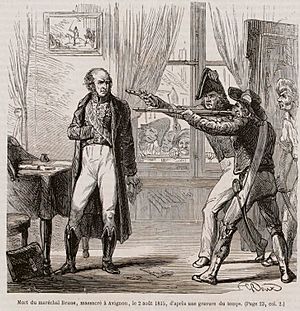Second White Terror facts for kids

The Second White Terror was a difficult time in France between 1815 and 1816. It happened after Napoleon lost the Battle of Waterloo on June 18, 1815. After Napoleon's defeat, Louis XVIII became King of France again. This period of Napoleon's brief return to power was called the Hundred Days.
During the Second White Terror, people who were thought to support the French Revolution, Napoleon, or who were Protestants, faced harsh treatment. Many were killed by angry groups of people or executed quickly after a trial.
Historian John B. Wolf explains that a group called the Ultra-royalists led this period. These were people who strongly supported the king. Many of them had just returned to France after being forced to leave. They wanted to reverse the changes brought by the French Revolution and Napoleon's rule.
In southern France, in places like Provence and Avignon, the White Terror was very intense. The royalists believed that many French people were disloyal to the king. They tried to find and punish anyone they saw as an enemy. The government at the time did not, or could not, stop these actions.
This period was named after an earlier event called the First White Terror. That happened in 1794–1795, when people linked to Robespierre's "Reign of Terror" were also attacked and killed.
What Was the Second White Terror?
The Second White Terror mainly involved removing people from government jobs who had supported Napoleon. About 70,000 officials lost their positions. Napoleon's army was also broken up after the Battle of Waterloo. Many of its high-ranking officers were removed from their duties.
Key Figures Affected
Several important military leaders faced severe consequences:
- Marshal Ney was executed for disloyalty.
- Marshal Brune was killed by a royalist group in Avignon.
- General Jean-Pierre Ramel was killed in Toulouse.
About 6,000 people who had supported Napoleon were put on trial. In southern France, especially in Marseille, around 300 people were killed by angry mobs. For example, in Marseille, at least eighteen of Napoleon's Egyptian soldiers, known as Mamelukes, were killed in their barracks.
The "Unobtainable Chamber"
The violent actions of the White Terror made many people afraid. This fear influenced voters in the August 1815 elections. People who were more moderate or liberal voted for the ultra-royalists.
The new Chamber of Deputies, which is like a parliament, had 350 ultra-royalists out of 402 members. King Louis XVIII himself called it the Chambre introuvable, which means "the Unobtainable Chamber." He called it this because it was "more royalist than the king" – meaning its members were even more extreme in their support for the king than he was.
Meanwhile, the Chamber of Peers, another part of the government, sentenced Marshal Ney and the Comte de la Bédoyère to death for disloyalty. About 250 people were sent to prison, and others were forced to leave France. This included important figures like Joseph Fouché, Lazare Carnot, and Cambacérès.
People who had voted to execute King Louis XVI in 1792 were also forced into exile. The political part of the White Terror ended when King Louis XVIII closed down the Chambre introuvable in 1816. He did this because he worried that the ultra-royalists' extreme actions might cause another revolution.
See also
- White Terror (disambiguation)
- Red Terror (disambiguation)

